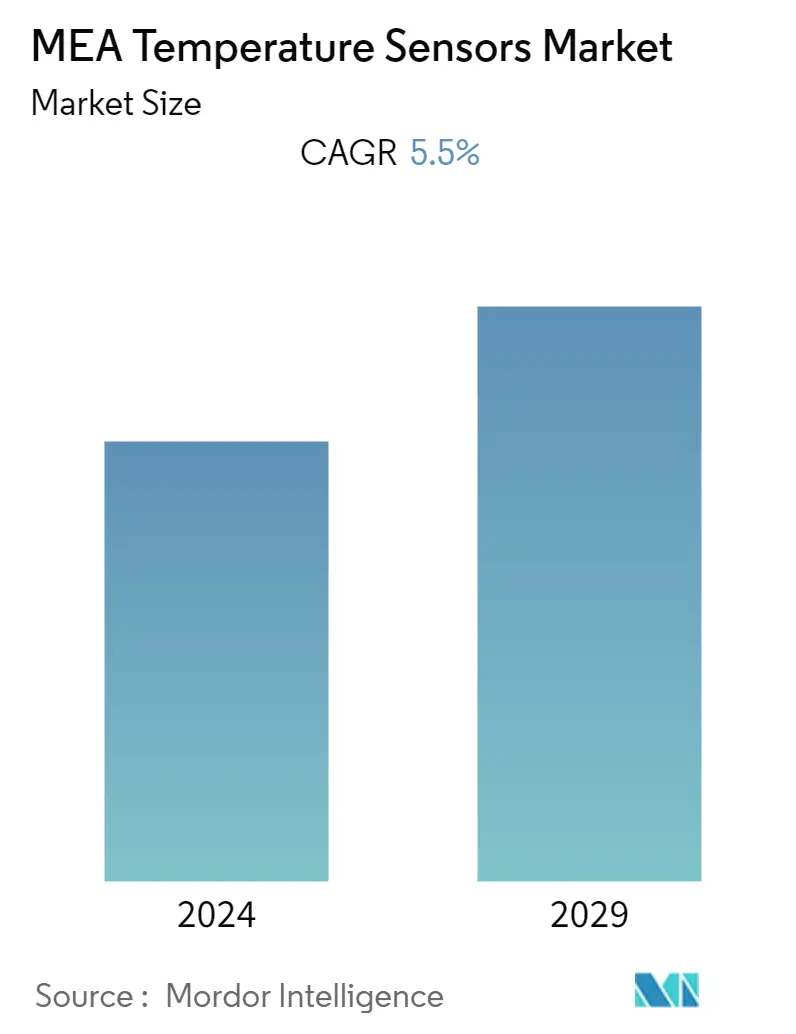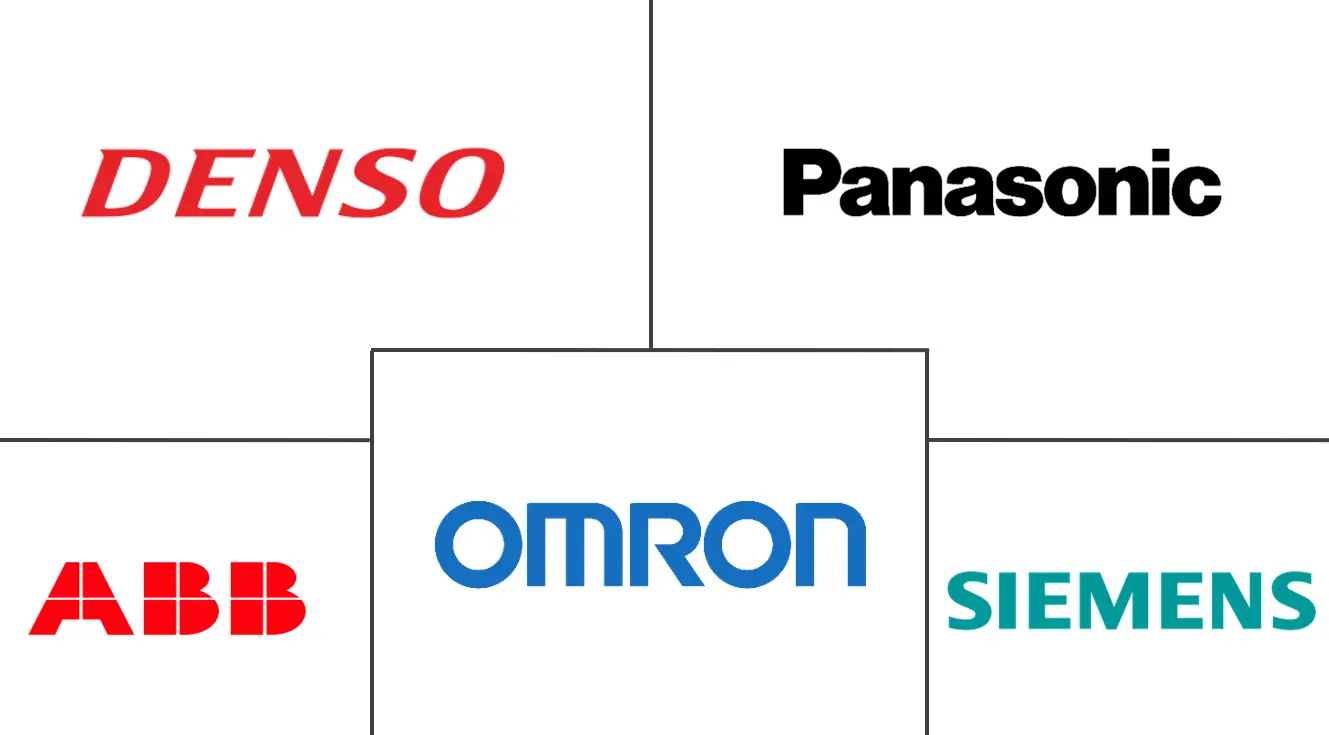Market Size of MEA Temperature Sensors Industry

| Study Period | 2019 - 2029 |
| Base Year For Estimation | 2023 |
| Forecast Data Period | 2024 - 2029 |
| Historical Data Period | 2019 - 2022 |
| CAGR | 5.50 % |
| Market Concentration | Medium |
Major Players
*Disclaimer: Major Players sorted in no particular order |
MEA Temperature Sensors Market Analysis
The Middle East and Africa, temperature sensor market, was valued at USD 674.8 million in 2020, and it is projected to be worth USD 931.6 million by 2026, registering a CAGR of 5.5% during the period 2021-2026.
- The region is one of the fastest-growing manufacturing industries in the region. Due to the government's anchor projects, low taxes, and business-friendly regulations, significant manufacturers of temperature sensors are expected to invest in the country.
- The United Arab Emirates has one of the robust automotive sectors in the GCC due to factors such as low import tariffs and low fuel costs. Dubai is expected to spend Millions of Dirhams on incentives to have 42,000 EVs on its streets by 2030. General Motors expects to see increased sales in the region with the launch of its Chevrolet electric vehicle. Besides, Dubai Police also operates a small fleet of Bolt EVs.
- Moreover, Saudi Arabia aims to shift from its oil-based economy and is in talks with Jordan and Egypt for a USD 500 billion industrial zone powered by renewable energy. Known as NEOM, the zone will focus on industries, including energy and water, biotechnology, food, and advanced manufacturing, propelling the demand for automation and encouraging the industry players to invest in the region.
- Due to the outbreak of COVID-19, the global supply chain and demand for multiple products have majorly been disrupted, due to which wireless temperature sensors adoption is anticipated to be influenced until the end of the year 2020. However, the growing demand for medical applications is driving the market growth. Various players are investing and collaborating to cater to the requirements.
MEA Temperature Sensors Industry Segmentation
The temperature sensors are devices to measure temperature readings through electrical signals. The sensor is made of two metals that generate electrical voltage or resistance once it notices a temperature change. The temperature sensors have various types based on the technology type, such as Infrared, Thermocouple, Resistance Temperature Detectors (RTD), Thermistor, and others.
The report describes the type of sensors, such as wired and wireless, and also provides the study of output, which are analog and digital. The end-user industry is comprised of temperature sensor applications, and majorly includes Chemical & Petrochemical, Oil & Gas, Metal & Mining, Power Generation, Food & Beverage, Automotive, Medical, Aerospace & Military, and others. The study is also being provided based on the COVID-19 impact.
MEA Temperature Sensors Market Size Summary
The Middle East and Africa temperature sensor market is experiencing significant growth, driven by the region's expanding manufacturing and automotive sectors. Government initiatives, such as low taxes and business-friendly regulations, are attracting major temperature sensor manufacturers to invest in the region. The United Arab Emirates, with its robust automotive industry, is a key player, particularly with its push towards electric vehicles and incentives to increase EV adoption. Similarly, Saudi Arabia's efforts to diversify its economy away from oil dependency, through projects like NEOM, are fostering demand for automation and, consequently, temperature sensors. Despite disruptions caused by the COVID-19 pandemic, the market is buoyed by the rising demand for medical applications and the continuous discovery of oil and gas reserves, which necessitate advanced temperature monitoring solutions.
The automotive and oil and gas industries are prominent end-users of temperature sensors in the region. In South Africa, efforts to promote electric vehicles are encouraging government action to reduce import duties, while in Saudi Arabia, the oil and gas sector remains a significant consumer due to its reliance on petroleum-related industries. New exploration activities in countries like Kuwait and Oman are further driving market growth. The competitive landscape of the Middle East and Africa temperature sensor market is moderately concentrated, with a few major players dominating. However, advancements in electronic component measurement are enabling new entrants to expand their presence in emerging economies, thereby enhancing the market's competitive dynamics.
MEA Temperature Sensors Market Size - Table of Contents
-
1. MARKET DYNAMICS
-
1.1 Market Overview
-
1.2 Assessment of Impact of COVID-19 on the Industry
-
1.3 Market Drivers
-
1.3.1 Growth in Industry 4.0 & Rapid Factory Automation
-
1.3.2 Increasing Demand for Wearable in Consumer Electronics
-
-
1.4 Market Restraints
-
1.4.1 Fluctuation in Raw Material Prices
-
-
1.5 Industry Value Chain Analysis
-
1.6 Industry Attractiveness - Porter's Five Force Analysis
-
1.6.1 Bargaining Power of Suppliers
-
1.6.2 Bargaining Power of Buyers
-
1.6.3 Threat of New Entrants
-
1.6.4 Threat of Substitute Products
-
1.6.5 Intensity of Competitive Rivalry
-
-
-
2. MARKET SEGMENTATION
-
2.1 By Type
-
2.1.1 Wired
-
2.1.2 Wireless
-
-
2.2 By Technology
-
2.2.1 Infrared
-
2.2.2 Thermocouple
-
2.2.3 Resistance Temperature Detector
-
2.2.4 Thermistor
-
2.2.5 Temperature Transmitter
-
2.2.6 Fiber Optic
-
2.2.7 Others
-
-
2.3 By End-user Industry
-
2.3.1 Chemical and Petrochemical
-
2.3.2 Oil and Gas
-
2.3.3 Metal and Mining
-
2.3.4 Power Generation
-
2.3.5 Food and Beverage
-
2.3.6 Automotive
-
2.3.7 Medical
-
2.3.8 Aerospace and Military
-
2.3.9 Consumer Electronics
-
2.3.10 Other End-user Industries
-
-
2.4 By Country
-
2.4.1 UAE
-
2.4.2 Saudi Arabia
-
2.4.3 Rest of Middle East and Africa
-
-
MEA Temperature Sensors Market Size FAQs
What is the current MEA Temperature Sensors Market size?
The MEA Temperature Sensors Market is projected to register a CAGR of 5.5% during the forecast period (2024-2029)
Who are the key players in MEA Temperature Sensors Market?
Siemens AG , PANASONIC CORPORATION , ABB LIMITED , DENSO CORPORATION and Omron CORPORATION are the major companies operating in the MEA Temperature Sensors Market.

